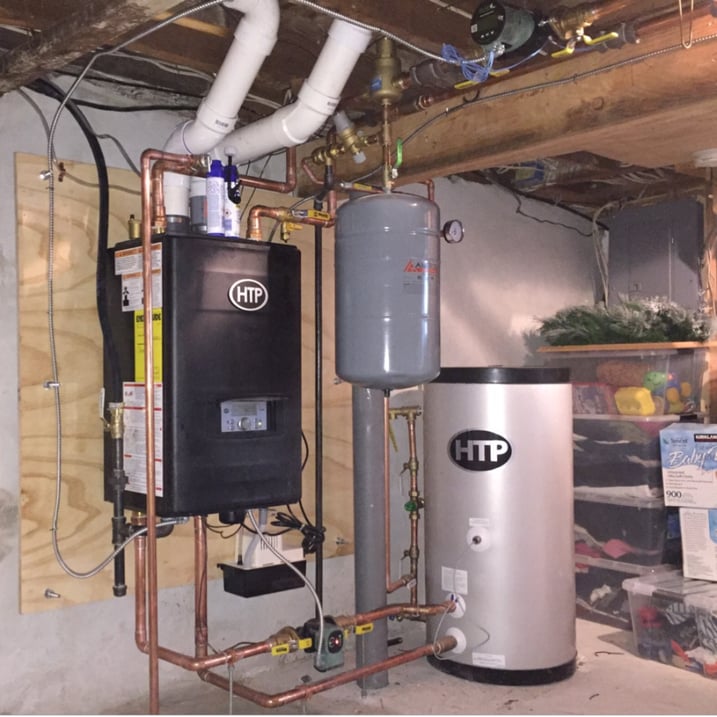An indirect water heater is a tank with an internal heat exchanger using hot water heated by the boiler, which is distinct from a separate water heater with it's own burner that would need it's own flue.
Not to be overhyping HTPs product, but here is a picture of a UFT-series boiler system with an indirect fired water heater (looks like one of the largest boilers in the series, but the topology would be the same for the smallest-in class):
The pump at the ceiling joists is running the heating system- any zoning that may or may not exist are not in the picture, but with a smart-pump like Viridian it's easy to run several zones with zone valves efficiently.
The pump near the slab is dedicated to the indirect water heater. Note that there is a separate plumbing port on the bottom of the boiler specifically designed for supporting an indirect water heater. While it's common to run indirect hot water using other modulating condensing boilers, most only have a single port, which adds to the plumbing & control complexity. Also note that it's just one pump on the heating side, no primary/secondary plumbing required, which also simplifies installation.
The UFT series has fewer bells & whistles in the controls than some boilers, but it's pretty cheap & rugged, easier to install than many comparable boilers and has a 10:1 turn down ratio, all of which makes it easy enough to like. But if there is no local or regional support for them in your area I would NOT recommend them. If the local supply house that recommends the Vmax 153P has good support for NTI, the
Trinity TX51 or TX81 are plus an indirect water heater would be pretty good options for a 4 zone system and a 40,000BTU/hr design load. The min-fire output of the TX51 is about 6700 BTU/hr, which only needs ~30' of baseboard per zone to not cycle at all, the min-fire output of the TX81 is about 9800 BTU/hr, which would need about 50' per zone to not cycle at all, and it's still only 1/4 the design heat load, which means if you tweaked in the outdoor reset curve to near-perfection it would still be modulating well into the shoulder seasons.
Using a 4%/1000' derating factor the max input of 57,000 BTU/hr for the TX51 makes it a bit marginal for a 40,000 BTU/hr load, but the TX81 (like the UFT-080W) would still have plenty. Mind you, a 4% per 1000' capacity derating is an exaggeration for this type of boiler since it's not a fixed gas orifice running at a constant pressure- the controls have feedback that automatically adjusts it some even without specific designs features for altitude compensation, but consult with the manufacturer for altitude derating. Many/most just parrot the old-school theoretical measures as if it were a non-modulating burner with a fixed combustion air mixture, others actually test them, or have even designed-in altitude compensation into the controls. (Lochinvar's Crest series commercial boilers are completely self-compensating for altitude).
A more realistic generic derating for most modulating condensing boilers would be ~2% per 1000' give or take, but it varies. At a 2%/1000' derating you'd still have adequate margin for a ~40K load even with the TX51. Note the derating tables on page 6 of
the installation manual- the derating numbers in Canada are different from the 4%/1000' they use for team USA. eg: at 4500' they derate by 10% in Canada, compared to 18% in the US, but it's the same boiler, same fuel, same air pressure. That's pretty typical. The only apparent differences are code requirements, not physics. A derating of 10% @ 4500' would be 2.2% per 1000'. Projecting that to 8300' would be about an 18% reduction in capacity, so the 52,000 BTU/hr DOE output would of the TX51 would still be north of 42,000 BTU/hr, which is still fine for a design heat load of 40,000 BTU/hr.
Many people would balk at cutting it that close if that's the real number, but since you have a wood stove for auxilliary heating on the super-cold nights it's not really worth upsizing for. A proper, more aggressive and accurate Manual-J load calcualtion would likely come in more than 10% lower than the Slantfin or Loadcalc tools, or other freebies. To get a good handle on it DO use those free tools to put some stakes in the ground- just know that those are on the high side of what more sophisticated tools & methods come up with. If a free load calculation tool comes up with a load of 45,000 BTU/hr, the likely reality is 40K, or less.
The degradation of lifecycle and efficiency short cycling has on the boiler isn't simple to quantify- a lot depends on just how much short cycling over how many hours per year. With sub-2-minute burns and 15+ burns per hour the impact is pretty heavy, taking something like 10% off the efficiency, erasing pretty much anything gained by the higher combustion efficiency. The necessary flue purges at every ignition cycle alone blows away a significant percentage of the total heat released during the burn.
The wear & tear on ignition components are high. The design presumption for most heating equipment would be on the order of 5 to at most 50 burn cycles per day. If it's doing 10 burns per hour all day and night that's 240 cycles per day. A weeks' worth of short cycling at 10 burns/hr is over 1500 burn cycles, which is more ignition cycles than a well designed system would run in a year. You'll get more than 15 years out of the ignition parts on a boiler in a well designed system, but probably not more 5 years in a short cycling system before parts need replacing.

